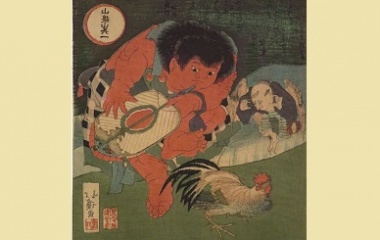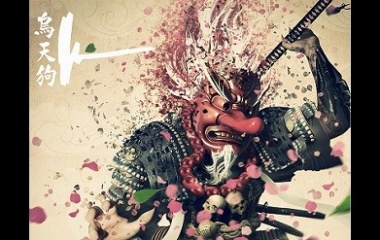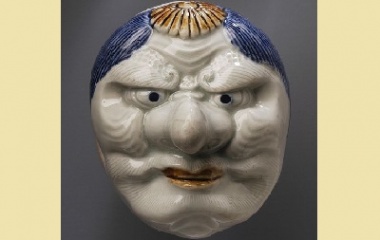What is a Tengu?
A Tengu is a supernatural spirit who springs from ancient Japan. These spirits are highly individual; they can be human or animal, good or bad, powerful or weak. They are most famous for plaguing Buddhist monks and abbeys, but even this is not a universal rule. Some of them bring blessings to the religion!
Characteristics
Physical Description
When the first Tengu fell to earth in a meteor of fire, he had a mixture of human and canine features, earning him the nickname “heavenly dog.”
Gradually, the race of dog-men shifted into a race of bird-men. Their claws were replaced with talons, their fur with feathers, and their muzzles with beaks. Then, as more centuries passed by, the bird-man form evolved even further. The spirits became more and more human, losing many of their bird features, like their beak, which was replaced by a very long nose. Despite taking on a more human look, they were still easily distinguished from humans by their huge, hawk-like wings and their deep red skin.
The most human of the Tengus add to their human look by wearing clothing and carrying tools. They particularly like to mimic Buddhist priests and monks, especially from the yamabushi sect. They can be found parading themselves around in the yamabushi’s light yellow or deep orange tunics, complete with tokins, a small black cap worn on the forehead, and yuigesas, a vest of six brightly colored pom-poms, which symbolize the six Buddhist virtues. They may also carry a shakujo staff, like powerful Buddhist priests do, and a ha-uchiwa fan, which they use to control the wind.
Personality
Japanese legend contains both good and bad Tengus. In the early years of their fame, they were mostly bad, but recent years have seen them making a turn for the better. Japanese philosophers have also noted that there is a wide range of power among these spirits; the wisest and most powerful are referred to as daitengu, while the smaller and more ignorant spirits are called kotengu.
These spirits have strong ties to the Buddhist community. Many of them nurse a deep-rooted hatred for the Buddhists, which they express by kidnapping, trying to corrupt, or even killing priests and monks. They have also been responsible for the destruction of several temples and abbeys. On the other hand, some of them love the Buddhists and choose to protect them.
Many Tengus fall into the camp of war-loving spirits. Not only are they talented martial artists, they are happy to teach their skills to mortal men, in order to fill the world with warriors. In some cases, their motive is noble: they teach sound-hearted men who want to fight for a for noble cause. In other cases, they simply want to encourage chaos and destruction.
Finally, these spirits have a strong connection to nature. They are especially drawn to mountains and forests, and they will defend their territory mercilessly. Plucking a single leaf from a Tengu’s home might bring his wrath whirling down upon you.
Special Abilities
Tengus are not called “heavenly dogs” for nothing. Their magic runs deep, and they are incredibly powerful.
They can shapeshift and possess human beings, two talents which they often use when they target monks. They can morph into the shape of a revered priest, or even the Buddha himself, to try to spread false messages, and they can possess beautiful young women to try to seduce the novice monks.
They weave magic into their already formidable martial art skills. Their ability to fly means that they can pull off dazzling aerial attacks, and their ability to shapeshift make them a thousand times nimbler than the best human warrior. They can simply turn into a sparrow to dodge an attack!
Finally, they exercise control over the weather. They have a special knack with the wind, which they can easily whip into tornados or hurricanes, but they can also summon rain, thunder, and hail when they feel threatened. They enjoy playing with fire, as well, and they can reduce an abbey to charred earth in just minutes.
Related Creatures
In early texts, the Tengu was actually named “Tiangou.” At some point in history, the bird-like Tengu split away from the dog-like Tiangou, and the spirits took on separate identities. The Tiangou developed its own tradition, being described as a black dog or meteor responsible for eclipses.
Tengu legend might have been influenced by the huli jing (“heavenly fox”). Based on their names alone, it is easy to imagine that ancient Japanese people might have muddled the “heavenly dogs” and “heavenly foxes.” The characters have many tell-tale similarities, like their tendency to shapeshift into beautiful women and to spread false-messages among Buddhists.
Another player in the Tengu’s evolution is Garuda, a Hindi god who took the shape of a bird of prey. Buddhist writings converted the god, Garuda, into a race of beings called garudas. These bird spirits were famous for their malice against monks.
Finally, Tengus can be interpreted as a sort of Japanese ghost. Philosophers in the 13th century AD explained that these demigods were actually the spirits of the dead. In many cases, they were spirits of angry, vain, or corrupt priests, but they could also be pious men. Men who were powerful in life became daitengu, while the weak became kotengu.
Cultural Representation
Origin
The Tengu first appeared in Japan in the 7th century AD. He was a popular character in picture scrolls, which provided rich illustrations but little written explanation. Folklore embraced these picture scrolls, and the spirits developed a rich oral tradition. By the 12th century, they had been picked up by Japanese philosophers and Buddhist monks, who tried to outline their lineage and classify their types, as well as documenting where they lived and what they were up to.
Famous Myths
In early folktales, the Tengu are mischievous but easily duped. For example, one famous story tells of a little boy who liked to peer through a hollow bamboo stick, pretending that he could see faraway places. A Tengu saw him at his game and became smitten with the bamboo stick, so much so that he offered to give the boy a invisibility cloak in exchange for the stick. The boy accepted the trade and made off with the priceless cloak, while the Tengu was still trying to peer through the worthless bamboo. In another story, a Tengu asks a gambler what he is most afraid of. The gambler replies that he is afraid of gold and riches. The Tengu then makes gold and rice cakes rain down upon him, thinking that he is distressing the gambler.
In later legends, the Tengu emerged as mighty forces. Several abbeys describe monks who climbed high into the priestly order, until they were exposed as Tengus. One story even claims that a Tengu became an abbot. After he was exposed, he fled the abbey but continued to work miracles there, unseen. Stories of Tengu kidnappings were also popular. The famous warrior Minamoto no Yoshitsune was abducted and trained by one of the bird-men, and there are even rumors about Tengu-training scattered throughout ninja-lore.
Modern Usage
Today, the Tengu have made a full-circle back to the picture scrolls of their youth. They are popular characters in Japenese manga magazines, which tell stories mainly through their illustrations.
There are also small cults of people who worship the bird-men, scattered across Japan. The three Tengu with the most followers are Soujoubou of Kurama, Taroubou of Atago, and Jiroubou of Hira. Their followers collect at shrines in Kyoto and the Hira Mountains, where these great spirits are sail to dwell, and give prayers and offerings to the spirits. Festivals are sometimes held for Tengu as well.










